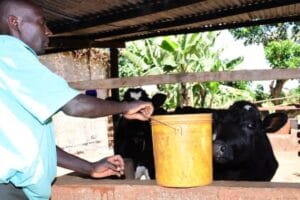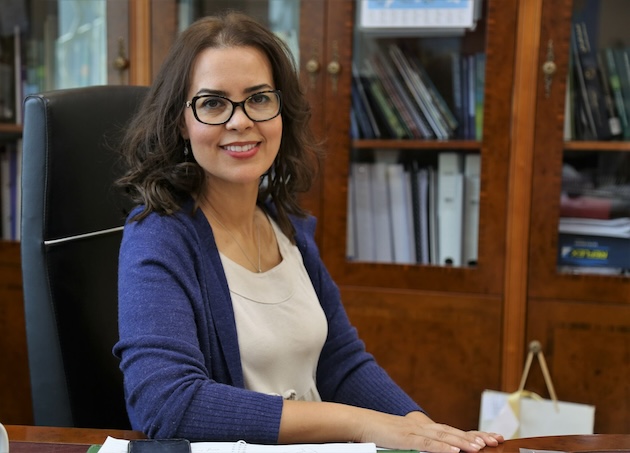
Africa, Climate Action, Climate Change, Conferences, Editors’ Choice, Environment, Europe, Featured, Food and Agriculture, Food Security and Nutrition, Food Sustainability, Global, Headlines, Ocean Health, Sustainable Development Goals, TerraViva United Nations

Fishermen gliding on a canoe off the coast of Dar es Salaam. Photo by Kizito Makoye
– With less than six harvest seasons left to meet the Sustainable Development Goals (SDGs), the urgency to find transformative solutions to end hunger, protect the oceans, and build climate resilience dominated the ninth panel session at the 2025 United Nations Ocean Conference in Nice, France.
In a moment emblematic of growing African leadership in ocean sustainability, Tanzania took center stage during the panel titled “Promoting the Role of Sustainable Food from the Ocean for Poverty Eradication and Food Security.” The panel offered not only a scientific and policy-rich exchange of ideas but also a rare glimpse into how countries like Tanzania are positioning aquatic foods as engines of economic recovery, public health, and ecological sustainability.
A Defining Voice From the Swahili Coast
Co-chairing the session, Shaaban Ali Othman, Minister for Blue Economy and Fisheries of Zanzibar, part of the United Republic of Tanzania, laid out his country’s blueprint for harnessing ocean resources without compromising marine ecosystems.
“Our survival is intimately tied to the ocean. It feeds us, it employs our people, and it holds the promise to lift millions out of poverty,” Othman said, advocating for a redefinition of how the world views aquatic food systems. “But this can only happen if we manage them responsibly.”
He emphasized that for Tanzania, the blue economy is not a buzzword—it is a foundational strategy woven into national development planning. As climate change intensifies and traditional farming struggles under erratic rainfall, coastal and inland aquatic foods offer a viable, nutrient-dense alternative for the country’s growing population.
“Communities in Zanzibar and along the Tanzanian coastline have fished for generations, but now we must ensure those practices are not just traditional, but also sustainable and inclusive,” Othman said.
He pointed to Zanzibar’s push to increase seaweed farming, particularly among women, as a double dividend for nutrition and gender equity. He also highlighted new investments in cold storage and fish processing facilities aimed at reducing post-harvest losses—currently among the highest in the region.
The Global Science Backs Tanzania’s Approach
His remarks resonated with the scientific panelists, particularly Jörn Schmidt, Science Director for Sustainable Aquatic Food Systems at WorldFish, who urged countries to bring aquatic foods “from the margins to the mainstream.”
“Aquatic foods are one of the few tools that can simultaneously tackle poverty, hunger, and climate risk,” said Schmidt. “But they are often left off the table—both literally and figuratively.”
Schmidt called for urgent action on three fronts: nutrition, production, and equity. He cited research showing that even modest increases in aquatic food consumption in the first 1,000 days of life could significantly reduce stunting and improve cognitive development. For production, he recommended low-impact, high-return systems such as seaweed and bivalves. On equity, he urged secure tenure for small-scale fishers, gender inclusion, and expanded social protections.
Barange noted that in 2023 alone, global fish production hit 189 million tons, delivering about 21 kilograms of aquatic animal protein per capita. However, an alarming 23.8 million tons—almost 15 percent—was lost or wasted due to poor handling and inefficient distribution systems.
“These losses are not just about food—they are lost nutrition, lost income, and lost opportunity,” said Barange, adding that if properly managed, aquatic foods could be the backbone of a global “blue transformation.”
Tanzania’s Call for Equity and Innovation
Othman used the opportunity to underline that the success of aquatic food systems must also address inequality—particularly the role of women and youth in the sector.
“Across Tanzania, from Kigamboni to Kilwa, women are drying fish, farming seaweed, and selling aquatic produce in markets. But they need access to capital, to better technology, and most importantly, to decision-making spaces,” he said.
To that end, Tanzania has begun piloting aquatic food training centres aimed at equipping youth with climate-smart aquaculture skills, including sustainable pond farming and low-carbon feed techniques.
“This is how we move from potential to prosperity,” Othman said.
A Blueprint for Global Action
The panel also featured a range of high-level contributions aimed at linking aquatic foods to broader development frameworks. Rhea Moss-Christian, Executive Director of the Western and Central Pacific Fisheries Commission, underscored the economic lifeline that tuna fisheries represent for small island developing states. She emphasized that tuna is not just a food source, but a pillar of public finance, especially in the Marshall Islands and the Federated States of Micronesia.
“Let’s be clear,” she said. “In some Pacific nations, tuna revenue funds schools, hospitals and roads. A healthy tuna fishery is existential.”
Her message echoed Tanzania’s own struggle to balance economic imperatives with conservation, especially in the face of illegal fishing and weak monitoring infrastructure. Minister Othman called for stronger regional cooperation in fighting these threats, including shared surveillance and satellite-based monitoring systems.
CGIAR and the Seaweed Solution
Adding another layer of urgency, Dr. Shakuntala Haraksingh Thilsted of CGIAR warned that the world is “falling behind on SDG 2 and SDG 14.” She championed seaweed as a sustainable aquatic superfood with enormous potential, particularly for South Asia and Africa.
“Tanzania, with its long coastline and established seaweed culture, is ideally placed to lead in this domain,” she said.
She called for more public and private investment to scale innovations, support local entrepreneurs, and integrate aquatic foods into school feeding and public procurement programmes.
“Let us not miss this opportunity,” she added. “The sea can feed us—if we let it.”
Resilience in the Face of Crisis
Ciyong Zou, Deputy Director-General of the United Nations Industrial Development Organization (UNIDO), highlighted the broader resilience benefits of aquatic food systems. He noted that aquatic foods support over 3 billion people globally, yet post-harvest losses—up to 30 percent in developing countries—undermine their potential.
He offered case studies from Cambodia and Sudan, where targeted investments in processing and training led to higher incomes and improved child nutrition. He announced UNIDO’s voluntary commitment to expand technical support to 10 additional coastal nations by 2030.
“For countries like Tanzania, this could mean new tools, cleaner production methods, and more resilient livelihoods,” Zou said.
Call to Action
As the panel drew to a close, one theme stood out: aquatic food systems are not merely about fish or seaweed—they are about dignity, sovereignty, and survival.
“We need to democratize access to data, empower communities, and ensure that small-scale fishers, especially women, are not left behind,” Othman insisted.
Back in Tanzania, the ripple effects of such commitments are already being felt. In Kisiwa Panza, a small island in Pemba, a women-led seaweed cooperative recently began exporting to Europe, thanks to technical support from local NGOs and government backing. “It’s a new life,” said Asha Mzee, one of the cooperative’s founders. “Before, we fished only what we needed. Now, we grow for the world.”
With nations like Tanzania stepping forward, the ocean—so long exploited—is being reimagined as a source of renewal. But the clock is ticking.
“In 2030, we’ll be asked what we did with these six remaining harvests,” Othman said in his final remarks. “Let’s ensure our answer is-we used them to feed people, protect our planet, and leave no one behind.”
IPS UN Bureau Report















